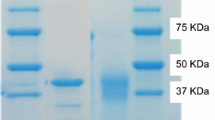Abstract
A GH5 hyperthermostable endoglucanase (Ph-GH5) from the archaeon Pyrococcus horikoshii and a commercial endoglucanase (FR) were used to treat bleached eucalyptus pulp (BEP) fibers to produce cellulose nanofibrils (CNF) and subsequently to CNF films. TEM imaging indicated that Ph-GH5 produced longer and more entangled CNF than FR with the same number of microfluidization passes. Physical and mechanical properties of CNF films were characterized. Optical opacity of CNF films from FR (10 mg/g) at 40 passes through the microfluidizer can be as low as 3.7 %, compared with 18.2 % from untreated BEP at the same number of passes. CNF films exhibited similar thermal stability with untreated BEP. Highest specific modulus of CNF films was also obtained from FR (10 mg/g), reaching 56 MNm/kg, approximately 271 % of the CNF films from untreated BEP at 40 passes through the microfluidizer. CNF film from Ph-GH5 (1 mg/g) at 40 passes provided the highest specific maximum tensile strength at 120 kNm/kg.






Similar content being viewed by others
References
Zhu JY, Zhuang XS (2012) Conceptual net energy output for biofuel production from lignocellulosic biomass through biorefining. Prog Energy Combust Sci 38(4):583–589
Pettersen RC (1984) The chemical composition of wood. In: Rowell RM (ed) The chemistry of solid wood advances in chemistry series, vol 207. American Chemical Society, Washington DC, pp 115–116
Brown RM (2004) Cellulose structure and biosynthesis—What is in store for the 21st century? J Polym Sci Part A 42:487–495
Iwamoto S, Kai W, Isogai A, Iwata T (2009) Elastic modulus of single cellulose microfibrils from tunicate measured by atomic force microscopy. Biomacromolecules 10(9):2571–2576
Fukuzumi H, Saito T, Iwata T, Kumamoto Y, Isogai A (2008) Transparent and high gas barrier films of cellulose nanofibers prepared by TEMPO-mediated oxidation. Biomacromolecules 10(1):162–165
Belbekhouche S, Bras J, Siqueira G, Chappey C, Lebrun L, Khelifi B, Marais S, Dufresne A (2011) Water sorption behavior and gas barrier properties of cellulose whiskers and microfibrils films. Carbohydr Polym 83(4):1740–1748
Pääkkö M, Ankerfors M, Kosonen H, Nykänen A, Ahola S, Österberg M, Ruokolainen J, Laine J, Larsson PT, Ikkala O et al (2007) Enzymatic hydrolysis combined with mechanical shearing and high-pressure homogenization for nanoscale cellulose fibrils and strong gels. Biomacromolecules 8(6):1934–1941
Henriksson M, Henriksson G, Berglund LA, Lindström T (2007) An environmentally friendly method for enzyme-assisted preparation of microfibrillated cellulose (MFC) nanofibers. Eur Polym J 43(8):3434–3441
Wang W, Mozuch MD, Sabo RC, Kersten P, Zhu JY, Jin Y (2015) Production of cellulose nanofibrils from bleached eucalyptus fibers by hyperthermostable endoglucanase treatment and subsequent microfluidization. Cellulose 22:351–361
Spence K, Venditti R, Rojas O, Habibi Y, Pawlak J (2011) A comparative study of energy consumption and physical properties of microfibrillated cellulose produced by different processing methods. Cellulose 18(4):1097–1111
Josset S, Orsolini P, Siqueira G, Tejado A, Tingaut P, Zimmermann T (2014) Energy consumption of the nanofibrillation of bleached pulp, wheat straw and recycled newspaper through a grinding process. Nord Pulp Pap Res J 29(1):167–175
Henriksson M, Berglund LA, Isaksson P, Lindström T, Nishino T (2008) Cellulose nanopaper structures of high toughness. Biomacromolecules 9(6):1579–1585
Sehaqui H, Zhou Q, Ikkala O, Berglund LA (2011) Strong and tough cellulose nanopaper with high specific surface area and porosity. Biomacromolecules 12(10):3638–3644
Qing Y, Sabo R, Cai Z, Wu Y (2013) Resin impregnation of cellulose nanofibril films facilitated by water swelling. Cellulose 20(1):303–313
TAPPI (2008) T 230 om-08. Viscosity of pulp (capillary viscometer method). Technical Association of the Pulp and Paper Industry, Atlanta, GA
Mazumder B, Ohtani Y, Cheng Z, Sameshima K (2000) Combination treatment of kenaf bast fiber for high viscosity pulp. J Wood Sci 46(5):364–370
TAPPI (2006) T 519 om-06. Diffuse opacity of paper. Technical Association of the Pulp and Paper Industry, Atlanta, GA
ASTM (2010) Annual Book of ASTM Standards, ASTM D638-10: standard test method for tensile properties of plastics. ASTM International, West Conshohocken, PA
Kilzer FJ, Broido A (1965) Speculation on the nature of cellulose pyrolysis. Pyrodynamics 2:151–163
Peng Y, Gardner DJ, Han Y, Kiziltas A, Cai Z, Tshabalala MA (2013) Influence of drying method on the material properties of nanocellulose I: thermostability and crystallinity. Cellulose 20(5):2379–2392
Fukuzumi H, Saito T, Okita Y, Isogai A (2010) Thermal stabilization of TEMPO-oxidized cellulose. Polym Degrad Stab 95(9):1502–1508
Roman M, Winter WT (2004) Effect of sulfate groups from sulfuric acid hydrolysis on the thermal degradation behavior of bacterial cellulose. Biomacromolecules 5:1671–1677
Wang Q, Zhu JY, Considine JM (2013) Strong and optically transparent films prepared using cellulosic solid residue recovered from cellulose nanocrystals production waste stream. ACS Appl Mater Interfaces 5(7):2527–2534
Ryu S-R, Lee D-J (2001) Effects of fiber aspect ratio, fiber content, and bonding agent on tensile and tear properties of short-fiber reinforced rubber. KSME Int J 15(1):35–43
Acknowledgments
We acknowledge the financial supports by a USDA Agriculture and Food Research Initiative (AFRI) Competitive Grant (No. 2011-67009-20056), Chinese Scholarship Council (CSC), National Natural Science Foundation of China (Grant Nos. 31070512 and 31370571). The funding from these programs made the visiting appointment of Wang at the USDA Forest Products Laboratory (FPL) possible. We also acknowledge Thomas Kuster of the Analytical Chemistry and Microscopy Lab of FPL for SEM imaging and Debra Sherman of DS imaging LLC, West Lafayette, IN, for TEM imaging. This work was conducted on official government time of Zhu, Kersten, Mozuch, and Sabo while Wang was a visiting student at the US Forest Service, Forest Products Lab.
Author information
Authors and Affiliations
Corresponding authors
Rights and permissions
About this article
Cite this article
Wang, W., Sabo, R.C., Mozuch, M.D. et al. Physical and Mechanical Properties of Cellulose Nanofibril Films from Bleached Eucalyptus Pulp by Endoglucanase Treatment and Microfluidization. J Polym Environ 23, 551–558 (2015). https://doi.org/10.1007/s10924-015-0726-7
Published:
Issue Date:
DOI: https://doi.org/10.1007/s10924-015-0726-7




